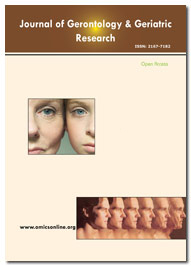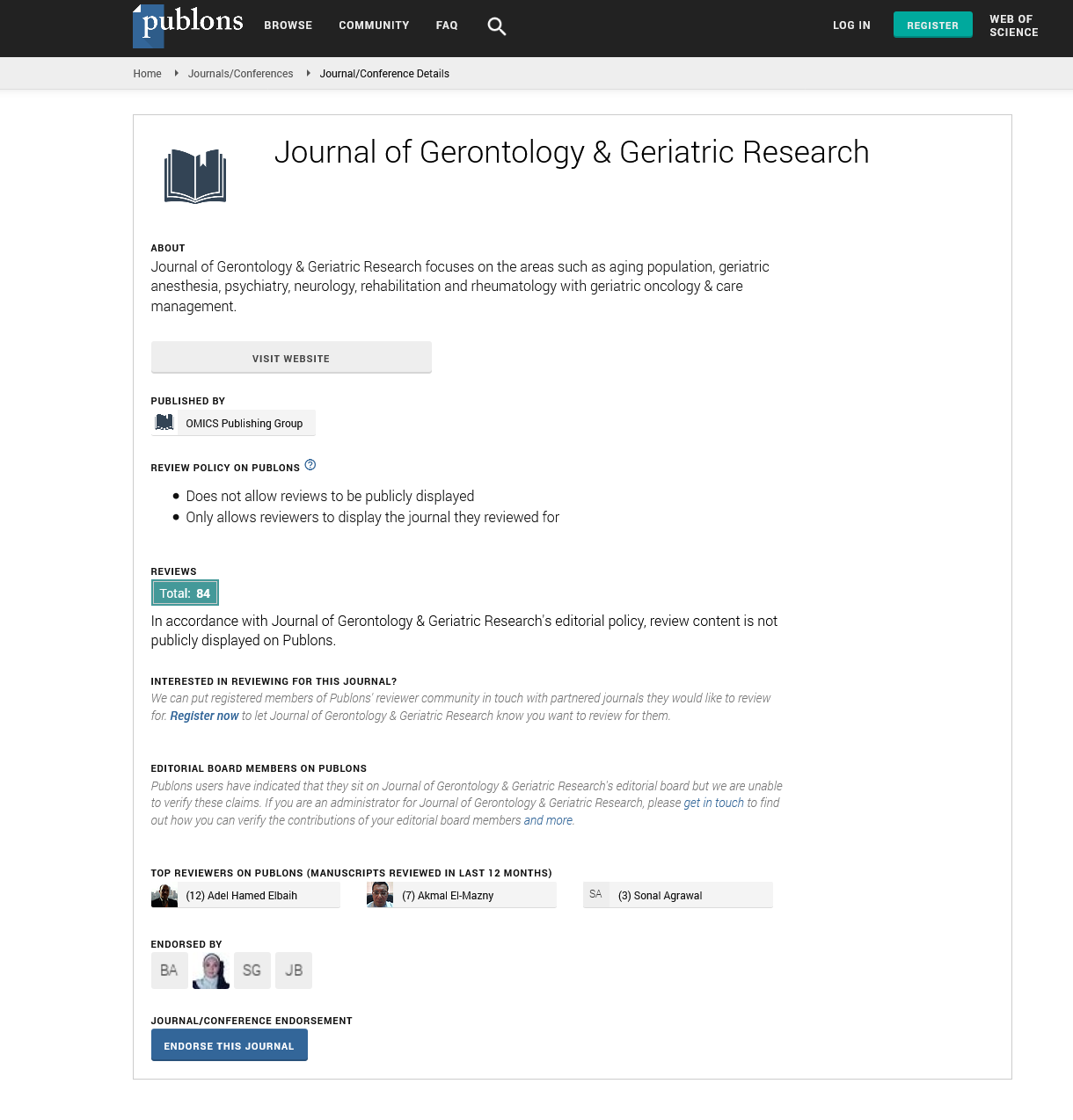Indexed In
- Open J Gate
- Genamics JournalSeek
- SafetyLit
- RefSeek
- Hamdard University
- EBSCO A-Z
- OCLC- WorldCat
- Publons
- Geneva Foundation for Medical Education and Research
- Euro Pub
- Google Scholar
Useful Links
Share This Page
Journal Flyer

Open Access Journals
- Agri and Aquaculture
- Biochemistry
- Bioinformatics & Systems Biology
- Business & Management
- Chemistry
- Clinical Sciences
- Engineering
- Food & Nutrition
- General Science
- Genetics & Molecular Biology
- Immunology & Microbiology
- Medical Sciences
- Neuroscience & Psychology
- Nursing & Health Care
- Pharmaceutical Sciences
Perspective - (2024) Volume 13, Issue 5
Age-Related Frailty: Mechanisms, Interventions and Implications for Geriatric Healthcare
Rib Halston*Received: 02-Oct-2024, Manuscript No. jggr-24-27662; Editor assigned: 04-Oct-2024, Pre QC No. P-27662; Reviewed: 17-Oct-2024, QC No. Q-27662; Revised: 23-Oct-2024, Manuscript No. R-27662; Published: 30-Oct-2024, DOI: 10.35248/2167-7182.2024.13.752
Introduction
Age-related frailty is a common and complex syndrome that affects a significant portion of the older population. Characterized by diminished strength, endurance, and physiological resilience, frailty leads to an increased vulnerability to adverse health outcomes such as disability, hospitalization, and mortality. As populations around the world continue to age, frailty is emerging as a major challenge to geriatric healthcare systems. Understanding the underlying mechanisms that contribute to frailty along with exploring potential interventions is crucial to improving the health and quality of life of older adults [1]. This article explores the pathophysiology of frailty, discusses current and emerging strategies for intervention, and examines the implications for healthcare providers who care for frail elderly patients.
In addition to the physical manifestations of frailty, the condition often intersects with other geriatric syndromes, such as cognitive decline, depression, and multimorbidity, creating a complex clinical picture that can be difficult to manage. Furthermore, frailty is not only influenced by biological aging but also by environmental factors like socioeconomic status, access to healthcare, and social support networks [2]. As frailty is often underrecognized in clinical practice, there is a growing emphasis on developing standardized tools for its early detection and assessment. Addressing frailty at its earliest stages offers the potential to mitigate its progression, reduce the burden on healthcare systems, and improve outcomes for the elderly population.
Description
Frailty is a multi-dimensional condition influenced by a combination of biological, psychological, and social factors. At the biological level, frailty is thought to arise from the gradual decline of multiple organ systems, including the musculoskeletal, cardiovascular, and immune systems, often exacerbated by chronic diseases and age-related inflammation. Nutritional deficiencies, physical inactivity, and cognitive decline are also contributing factors that further compromise an individual’s ability to cope with stressors [3]. Various models have been proposed to describe frailty, with the most widely accepted being the physical phenotype model, which includes unintentional weight loss, exhaustion, weakness, slowness, and low physical activity Interventions aimed at reducing frailty primarily focus on enhancing physical function and nutritional status. Resistance and aerobic exercise programs, along with nutritional supplementation (such as protein or vitamin D), have shown promise in improving muscle strength and overall physical performance [4].
Additionally, managing coexisting conditions like diabetes, hypertension, and depression is crucial in addressing frailty. Pharmacological interventions, including the use of anabolic agents or anti-inflammatory drugs, are being studied but have yet to show consistent benefits. Non-pharmacological approaches, such as cognitive training, social engagement, and personalized care plans, also play an important role in managing frailty and enhancing the quality of life for older adults. The implications for geriatric healthcare are profound, as frailty not only impacts the individual but also places a substantial burden on healthcare systems, caregivers, and families. Early identification and timely intervention are essential to prevent the downward spiral into severe frailty. Furthermore, healthcare providers need to adopt a holistic, individualized approach to frail elderly patients [5], focusing on improving functional capacity, promoting independence, and addressing the multi-faceted nature of the condition.
Conclusion
Age-related frailty is a significant public health concern with far-reaching implications for geriatric care. By understanding the underlying mechanisms of frailty, healthcare providers can implement targeted interventions that improve the quality of life for older adults, reduce healthcare utilization, and enhance the overall health of aging populations. While much progress has been made in identifying effective strategies for prevention and treatment, there is still much to learn about the full range of factors contributing to frailty and how best to address them. As the elderly population continues to grow, an integrated, multidisciplinary approach to managing frailty will be critical to meeting the healthcare needs of older adults, improving outcomes, and ensuring that aging individuals can maintain dignity and independence in their later years.
Furthermore, there is a need for greater awareness and education about frailty among healthcare providers, caregivers, and the general public. Early identification and proactive management can help slow or prevent the decline associated with frailty, but this requires systematic screening tools, routine assessments, and a holistic, patient-centered approach to care. Investment in research, as well as policy changes that support the development of comprehensive care models, are essential to addressing frailty at a population level. Initiatives that promote healthy aging, such as encouraging physical activity, improving nutrition, and supporting mental well-being, will go a long way in reducing the incidence and impact of frailty across different settings.
Acknowledgement
None.
Conflict of Interest
None.
References
- Carskadon MA, Brown ED, Dement WC. Sleep fragmentation in the elderly: relationship to daytime sleep tendency. Neurobiol Aging. 1982;3:321-327.
- Besedovsky L, Lange T, Haack M. The sleep-immune crosstalk in health and disease. Physiol Rev. 2019.
- Grimshaw JM, Eccles MP, Lavis JN, Hill SJ, Squires JE. Knowledge translation of research findings. Implement Sci. 2012:1-7.
- Richards KC, Wang YY, Jun J, Ye L. A systematic review of sleep measurement in critically ill patients. Front Neurol. 2020;11:542529.
- Ye L, Owens RL, Dykes P. Individualized sleep promotion in acute care hospitals: Identifying factors that affect patient sleep. Appl Nurs Res. 2019;48:63-67.
Google Scholar, Crossref, Indexed at
Google Scholar, Crossref, Indexed at
Google Scholar, Crossref, Indexed at
Google Scholar, Crossref, Indexed at
Citation: Halston R (2024). Age-Related Frailty: Mechanisms, Interventions and Implications for Geriatric Healthcare. J Gerontol Geriatr Res. 13: 752.
Copyright: © 2024 Halston R. This is an open-access article distributed under the terms of the Creative Commons Attribution License, which permits unrestricted use, distribution, and reproduction in any medium, provided the original author and source are credited.

